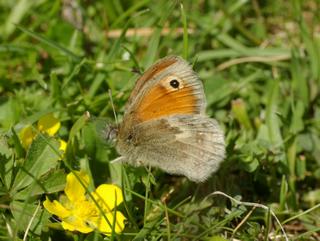
Small Heath. Photo’, K.McGee.
Worcestershire Record No. 23 November 2007 pp. 42-46
Kevin McGee
BUTTERFLIES.
Silver-washed Fritillary. Argynnis paphia (Nymphalidae, local).
One female was seen briefly visiting flowers of Creeping Thistle alongside the brook at Deerfold Wood near Drakes Broughton on 30.7.2007. This is my first record of one in this particular block of woods, this species also occurs at nearby Tiddesley, but it’s very infrequent there too. I would very much have liked to photograph this individual but it’s another one that got away!
Small Heath. Coenonympha pamphilus (Satyridae, local).
A couple were at Coombegreen and Hollybed Commons near the Malverns during a WBRC ‘Recorders Day’ on 7.7.2007, where I managed the photo shown. I saw another on set-aside land at Caddicroft Farm, Drakes Broughton on 26.8.2007. This is my 2nd record from this site. The species remains extremely uncommon in this part of the county.

Small Heath. Photo’,
K.McGee.
MACRO MOTHS.
Yellow-legged Clearwing. Synanthedon vespiformis (Sesiidae, notable B).
Two were photographed at Grafton Wood on 1.6.2007. They were in an area that had recently been cleared of undergrowth, with some felling of Oaks. I saw another at rest on an Oak trunk at Deerfold Wood, Drakes Broughton, on 17.6.2007.
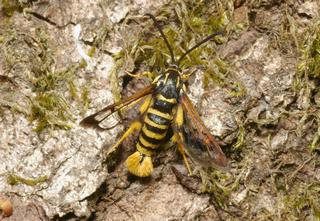
Yellow-legged Clearwing. Photo’, K.McGee.
Six-belted Clearwing. Bembecia ichneumoniformis (Sesiidae, notable
B).
A rather worn individual was found by Gary Farmer, then collected by Harry Green at Hollybed Common during the ‘Recorders Day’ on 7.7.2007. I would have depicted the photograph of it prior to its release but I was lucky enough to find one in much better condition at the Windmill Hill reserve on 31.7.2007. These are my first records of this elusive species.
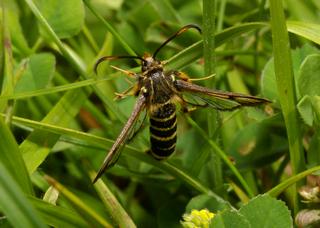
Six-belted Clearwing. Photo’, K.McGee.
Oak Eggar. Lasiocampa quercus (Lasiocampidae, common).
I found this larva low down near ground level on Damson foliage at Drakes Broughton Orchard on 15.5.2007. Weather conditions at the time were wet and gloomy, not ideal for photography. Some enhancement in Photoshop was required on the photo below! This is an uncommon species in the English Midlands.
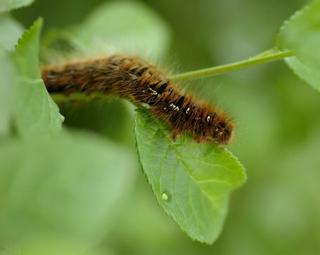
Oak Eggar. Photo’, K.McGee.
PYRALID MOTHS.
Sitochroa verticalis (Pyralidae, local).
One adult nectaring on Field Scabious flowers at the Windmill Hill reserve on 31.7.2007. My first record of this species.
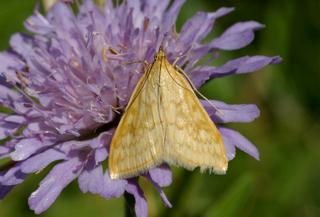
Sitochroa verticalis. Photo’, K.McGee.
MICRO MOTHS.
Spatalistis bifasciana (Tortricidae, notable B).
I was lucky to achieve one photograph of this scarce species at rest on an Aspen trunk before it took flight. Taken at Mill Meadow, Drakes Broughton on 29.5.2007. All previous county records are from the 10k square occupied by Wyre Forest.
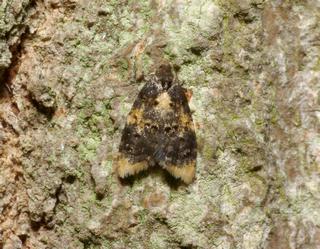
Spatalistis bifasciana. Photo’, K.McGee.
Glyphipterix forsterella (Glyphipterigidae, notable B).
One photographed on flowers of a Forget-me-not species at Grafton Wood on 1.6.2007. This may be a new site for this scarce species which is associated with Carex in damp areas of Worcestershire woodlands.
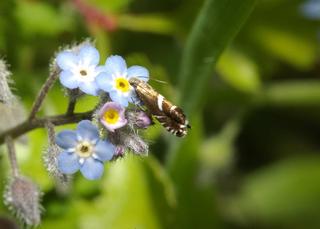
Glyphipterix forsterella. Photo’, K.McGee.
HETEROPTERA
Euredema oleracea (Pentatomidae, local).
The Brassica Bug. My first UK records for this mainly southern species were both from Oilseed Rape flowers near Deerfold Wood, Drakes Broughton on 5.5.2007 & 20.5.2007.
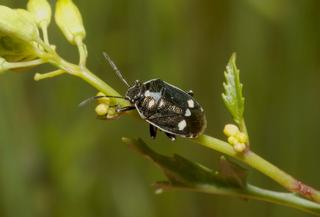
Eurydema oleracea. Photo’, K.McGee.
Corizus hyoscyami (Rhopalidae, local).
One of these striking red & black bugs was found on ground vegetation in the garden of ‘The Newalls’ at the Wyre Forest by John Partridge at the end of a Wyre Forest Study Group field trip on 21.4.2007. Just as I was about to take a photo it took flight and was not relocated! Please also see page 41 of the November 2006 issue of the Worcestershire Record for previous reports of this species which is yet another spreading up from the south.
Stictopleurus abutilon (Rhopalidae, rare vagrant).
I first found one of these amongst arable weeds on set-aside at Mill Rough, Drakes Broughton on 17.9.2006. The identification has been confirmed by P.F.Whitehead. Once again, this is normally thought as being a mainly southern coastal species in the UK. I continued to find them in one’s and two’s at the same location up until 15.10.2006, when the one shown below was photographed on Groundsel seeds.
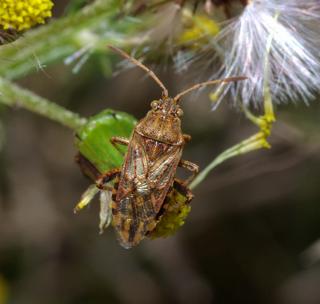
Stictopleurus abutilon. Photo’, K.McGee.
COLEOPTERA.
Platyderus ruficollis (Carabidae, notable B).
One collected from under a Birch log at the Devil’s Spittleful reserve on 26.3.2007.
Phymatodes alni (Cerambycidae, notable B).
One collected from low vegetation alongside Mill Rough, Drakes Broughton on 29.5.2007. My first record from this site and probably only the second for the county following the one I found at Castlemorton Common, also on 29th May, in 2003.
Stenostola dubia (Cerambycidae, notable B).
One on low vegetation at Mill Meadow, Drakes Broughton on 31.5.2007.
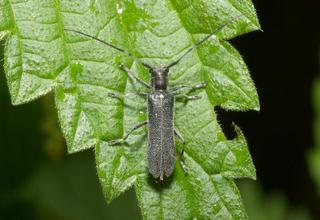
Stenostola dubia. Photo’, K.McGee.
Saperda populnea (Cerambycidae, local).
One on the foliage of an Aspen sapling at Grafton Wood on 1.6.2007. This is the first adult I’ve seen since one at Monkwood in 1998. I have very few records of this particular longhorn beetle.
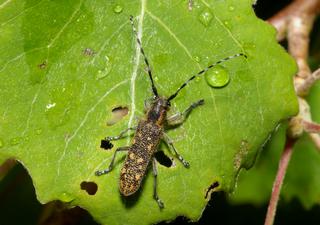
Saperda populnea. Photo’, K.McGee.
Ptinomorphus imperialis (Anobiidae, notable B).
One photographed on Ash foliage along a section of disused railway near Broadway on 3.6.2007.
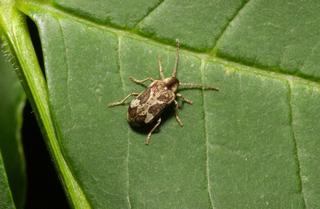
Ptinomorphus imperialis. Photo’, K.McGee.
Ampedus elongantulus (Elateridae, notable A).
One on low vegetation near the trunk of a fallen Oak at Mill Rough, Drakes Broughton constitutes my third record from this area now in as many years. All species of these red ‘click’ beetles are rare, their correct identification should be sought by an expert.
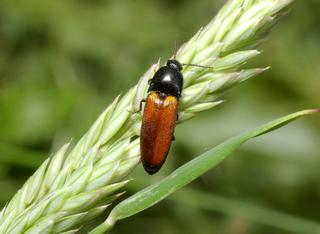
Ampedus elongantulus. Photo’, K.McGee.
Pterostichus lepidus (Carabidae, notable B).
One collected from sandy ground during the ‘recorders’ field trip at Burlish Top near Kidderminster on 4.8.2007. My first record of this heathland speciality.
DIPTERA.
Tachina ursina (Tachinidae, local).
One male collected from a fence-post near Dowles Brook in the middle of Wyre Forest on 27.3.2007. This was actually just on the Shropshire side. In life this was an amazing bee mimic and it had me completely baffled at first sight.
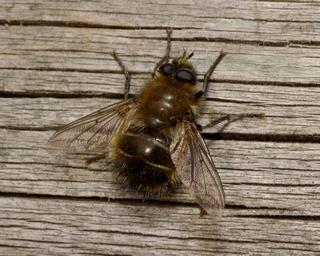
Tachina ursina. Photo’, K.McGee.
Criorhina floccosa (Syrphidae, scarce).
One female briefly visiting flowers of Field Maple and Hawthorn alongside Mill Rough, Drakes Broughton on 28.4.2007. My second record from this site.
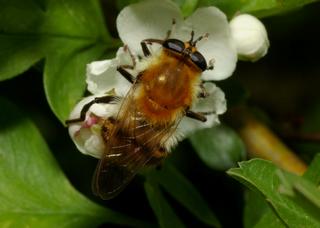
Criorhina floccosa. Photo’, K.McGee.
Criorhina asilica (Syrphidae, scarce).
I saw three this year, two in the Drakes Broughton area in mid May and this female on 30.5.2007 in Tiddesley Wood. She had been visiting Dogwood flowers just before a short sharp shower. When the sun re-emerged she sat very obligingly on some nearby foliage enjoying the warmth. All Hoverflies in the genus Criorhina can be extremely difficult to approach, they are usually very shy or very active.
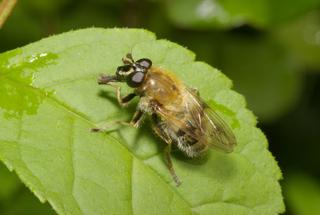
Criorhina asilica. Photo’, K.McGee.
Criorhina berberina (Syrphidae, local).
This female was on Bramble flowers at Mill Meadow, Drakes Broughton on 31.5.2007.
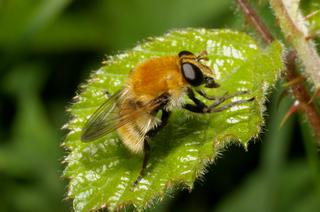
Criorhina berberina. Photo’, K.McGee.
Chalcosyrphus eunotus (Syrphidae, RDB2).
One male collected from streamside vegetation in Wyre Forest on 5.6.2007.
Hybomitra distinguenda (Tabanidae, local).
One male collected from alongside Dowles Brook, Wyre Forest on 5.6.2007. I thought it was a Hoverfly at the time of capture as it was actually ‘hovering’ in a stationary fashion at about head-height in much the same manner as some Eristalis species. This localised Horse Fly is new to me but is known from the Wyre environs.
Xanthandrus comtus (Syrphidae, scarce).
Two, male & female, at Wyre Forest on 24.7.2007.
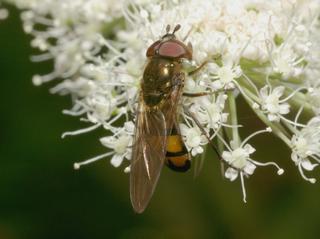
Xanthandrus comtus. Photo’, K.McGee.
Volucella zonaria (Syrphidae, scarce).
One female briefly on Bramble flowers at the foot of North Hill, Malverns on 27.7.2007.
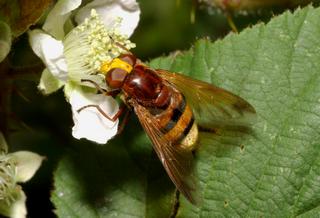
Volucella zonaria. Photo’, K.McGee.
Helophilus trivittatus (Syrphidae, local).
Large numbers of these were reported during August 2007. I started to find them from the end of July when I caught a male at the Windmill Hill reserve, then I saw several more at a number of widely scattered sites but could never successfully photograph one until this individual at Mill Meadow, Drakes Broughton on 26.8.2007.
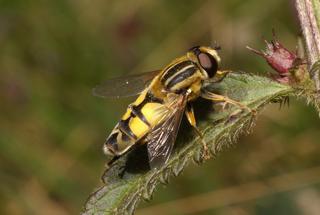
Helophilus trivittatus. Photo’, K.McGee.
Zodion notatum (Conopidae, RDB3).
One female collected from a low bank of bare ground alongside a track half-way up Bredon Hill on 3.8.2007. Despite being very small in comparison to most of its much commoner close relatives this was very much a typical Conopid in life with it’s distinctive robust nature and overall posture. It would have been nice to photograph it but I felt there was a risk of losing the opportunity of capturing what was obvious to me as ‘something different’.
Sargus flavipes (Stratiomyidae, local).
One female collected from Oak foliage at Hartlebury Common on 15.9.2007.
SYMPHYTA.
Pamphilius varius (Pamphilidae, local).
A female was photographed and collected from Honeysuckle foliage at Mill Meadow, Drakes Broughton on 19.5.2007. All Sawflies in this particular genus are considered local and uncommon.
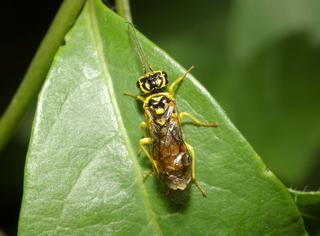
Pamphilius varius. Photo’, K.McGee.
HYMENOPTERA.
Odynerus melanocephalus (Eumenidae, notable).
One male photographed and collected from ground level vegetation along a footpath near Drakes Broughton Orchards on 22.5.2007. It’s very rare that an opportunity presents itself like this, but just occasionally it is possible to find species of normally very active hymenopterans sitting stationary because they have suddenly cooled down too quickly. I suspect this was the case with this one as the temperature did drop considerably that late afternoon during my usual ‘dog-walking session’.
I also collected a female at Wick Grange Farm near Pershore during the ‘Recorders Day’ organised for 9.6.2007.
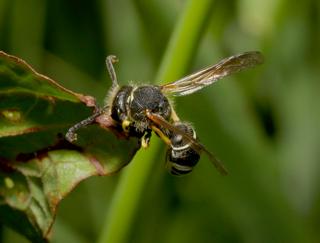
Odynerus melanocephalus. Photo’, K.McGee.
Auplopus carbonarius (Pompilidae, scarce).
Two females were collected from Mill Meadow, Drakes Broughton on 8.7.2007 & 5.8.2007. Another female was collected from Wyre Forest on 24.7.2007.
Dasypoda hirtipes (Melittinae, scarce).
I found this female just starting to excavate her nest burrow in the sand at Burlish Top near Kidderminster during a ‘Recorders Day’ on 4.8.2007. Many of us had the opportunity to photograph this scarce species in our region.
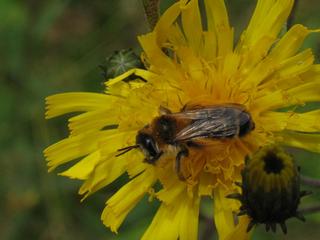
Dasypoda hirtipes. Photo’, K.McGee.
BIRDS.
Lesser-spotted Woodpecker. One female in the uppermost branches of an Ash at Mill Rough, Drakes Broughton on 4.1.2007 was a welcome sight, but better still was the pair present at the same location on 13.1.2007. The male was constantly being pestered by a Nuthatch. I had hoped these would stay and breed but I saw no evidence despite many visits.
MISCELLANEOUS.
Common Lizard. I was surprised to encounter one sun-bathing on the trunk of an old Damson near Drakes Broughton Orchard on the evening of 3.5.2007. It even allowed me to take several photo’s, please see below. I noticed that most of it’s tail was missing. This area can hardly be described as typical habitat suitable for Lizards. They must be breeding here as I saw a juvenile on an old log not far from the original sighting on 1.9.2007.
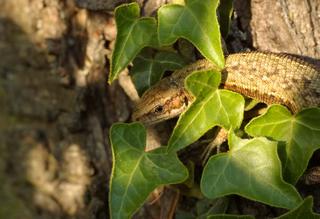
Common Lizard. Photo’, K.McGee.
Acknowledgements.
I would like to thank Mr.P.F.Whitehead, Dr.A.N.B.Simpson and Mrs.R.Winnall for their expertise and assistance.
Reference:
| SOUTHWOOD. T. & LESTON. D. 1959. Land and Water Bugs of the British
Isles. Frederick Warne & Co. Ltd. |
| WBRC Home | Worcs Record Listing by Issue | Worcs Record Listing by Subject |